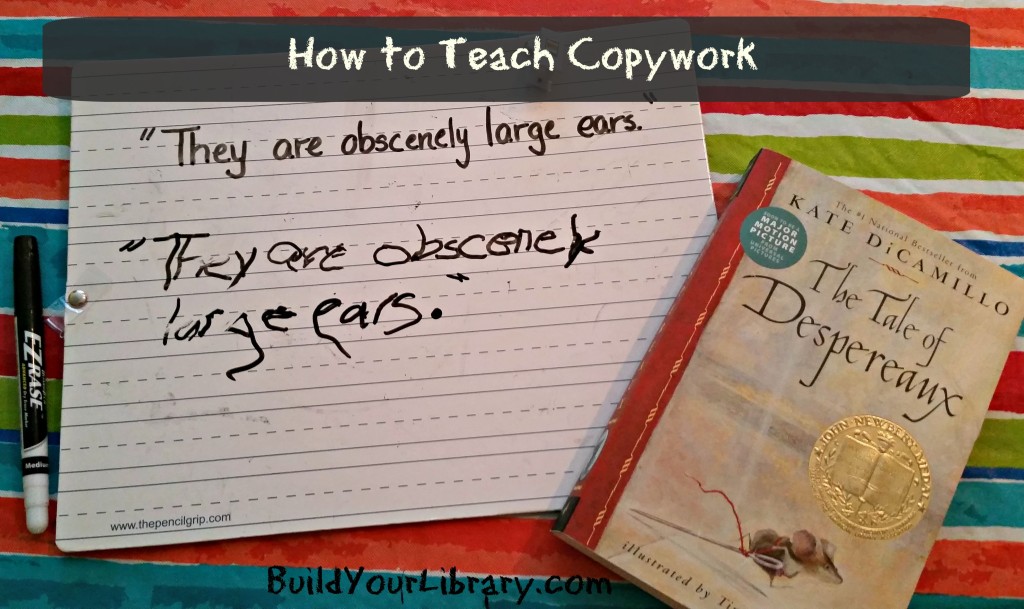How to Teach Copywork
July 27, 2015
Copywork can seem deceptively simple. Give your child a sentence or two and have them copy it. It can seem like pointless busywork, but the benefits are enormous.
First, copywork takes the place of penmanship practice. Once a child learns how to write their letters comfortably, they are ready to start simple copywork. Start with very short sentences and have them copy it in the best handwriting. It is important that they give their best effort. If you find them struggling, give them less to copy. In the beginning, it’s ok if they only do one word per sitting as long as that one word is in their best handwriting. You can gradually increase the length of the model as they become more and more comfortable. However – it is important to take their age into consideration. A typical 6-year-old isn’t going to be able to copy a paragraph worth of writing with their best effort.
Why do copywork at all?
Copying models of good writing teaches your child what good writing looks like. Many of the world’s greatest writers learned how to write through copywork. Jack London would copy out his favorite books in order to teach himself good writing; Benjamin Franklin would copy or outline essays and then try to recreate them on his own to see if he could write them better. By copying good writing, your child learns what good writing looks and feels like, thereby improving their own writing.
In the elementary grade levels, copywork can even take the place of formal language arts curriculum. You can use copywork to teach mechanics, such as proper punctuation and capitalization, as well as spelling, vocabulary, careful handwriting, and even parts of speech. You can teach them different writing techniques, such as how to write dialogue, different literary devices (metaphors, alliteration, etc.) There are so many different ways that it can help nurture your child’s writing abilities. Just choose one thing at a time to focus on. For a beginning 6-year-old, you might focus on beginning with a capital letter and ending punctuation. Your 9 or 10-year-old is ready to learn about parts of speech or how to format dialogue. Focus on just one thing at a time, spending as much or as little time as necessary until they understand.
How do you choose selections to copy?
If you want to teach good writing to your children, then you need to provide them with beautiful writing to copy. Choose passages from well-written books, poetry, songs, etc. When you use a Build Your Library grade level program or unit study, your copy work passages are chosen for you from the literature you and your child will be reading.
You can even use copywork to aid in memory work – I find that when we use our memory work as copywork it helps them to learn it quickly because they are using more of their senses – mind, hands, eyes, etc.
So what does copywork look like in a typical homeschool environment?
For a young child, I write their copywork very neatly on the top of a sheet of their writing paper. I read it over with them, pointing out anything of note. Then I have them copy it out in their best writing. If your child is a dawdler, you may wish to set a timer. It should take no longer than 10 – 15 minutes to complete. For an older child, I like to write out their copywork on a white board. I recommend doing copywork three days per week.
If you are using copywork to study grammar, mechanics, and spelling as well, you can use it in place of boring workbooks. You can copy the same passage twice. Once for practice, then again for study using a color-code system. You can study one part of speech at a time, giving each a different color. For example: nouns are red, verbs are blue, adjectives are green, etc. Then have them copy the passage using the color code system you have created. They can write it with gel pens or color pencils, or on your whiteboard with markers.
Remember, copywork isn’t only for children! We can keep our own “Commonplace Books” where we can jot down quotes from our own readings that strike our fancy. Not only is this good for our own self-education, but it’s also encouraging for our children to see that we are learning too.
 Emily Cook is the author and creator of the secular homeschool curriculum Build Your Library, a literature-based K-12 program infused with the teachings of Charlotte Mason. She writes full year lesson plans as well as shorter topical unit studies. Emily has been homeschooling her four children in Southern NH for 21 years. She is passionate about reading aloud to children of all ages and loves to share her love of literature with others. She and her family also makes incredibly dorky videos about homeschooling, books and more on Youtube at ARRRGH! Schooling. You can follow her on Facebook, Twitter and Pinterest.
Emily Cook is the author and creator of the secular homeschool curriculum Build Your Library, a literature-based K-12 program infused with the teachings of Charlotte Mason. She writes full year lesson plans as well as shorter topical unit studies. Emily has been homeschooling her four children in Southern NH for 21 years. She is passionate about reading aloud to children of all ages and loves to share her love of literature with others. She and her family also makes incredibly dorky videos about homeschooling, books and more on Youtube at ARRRGH! Schooling. You can follow her on Facebook, Twitter and Pinterest.

My kids are loving the copywork from Build Your Library. If they peek ahead in my planner, they listen to hear that phrase in the reading. I have been typing out the copywork for them and just putting it in a binder for them along with lined paper.